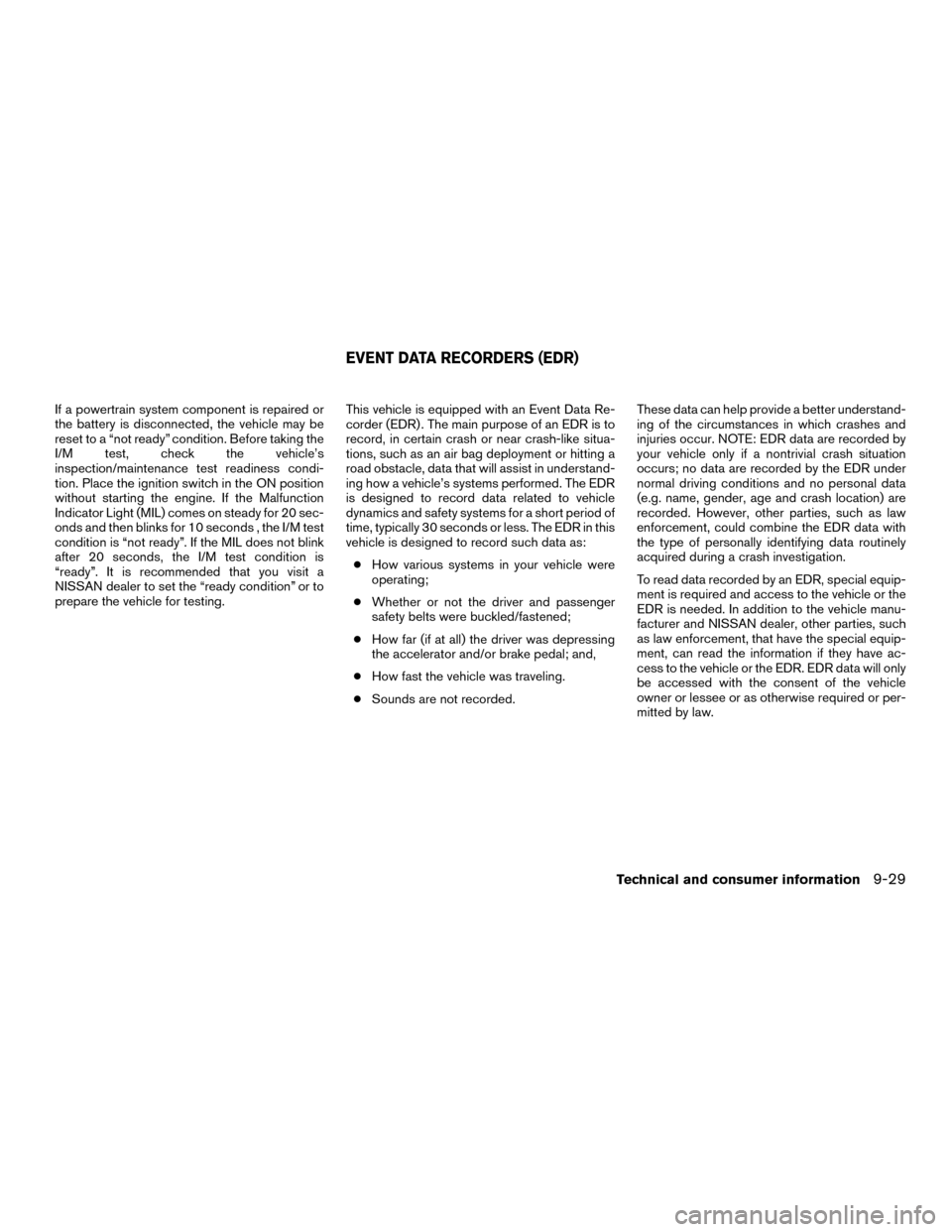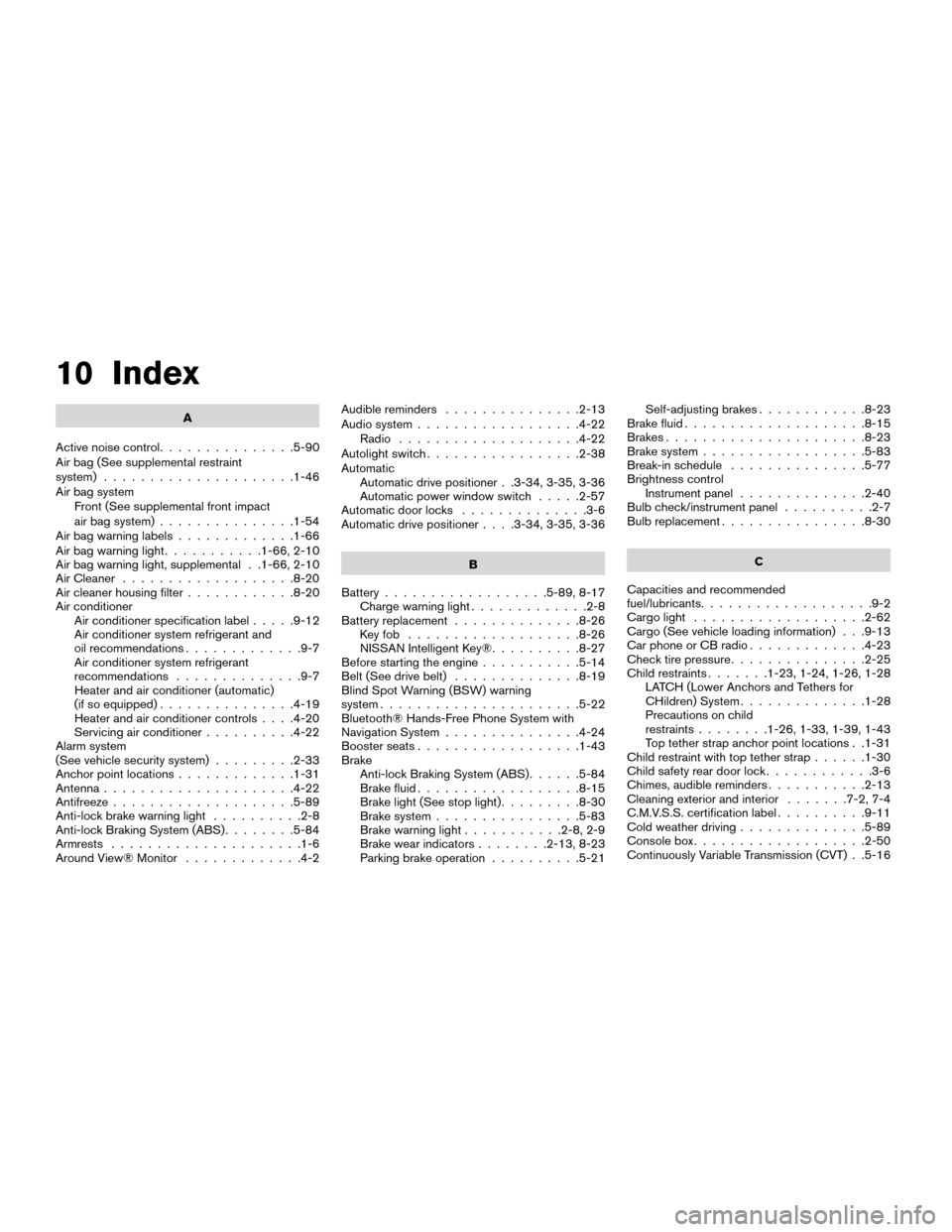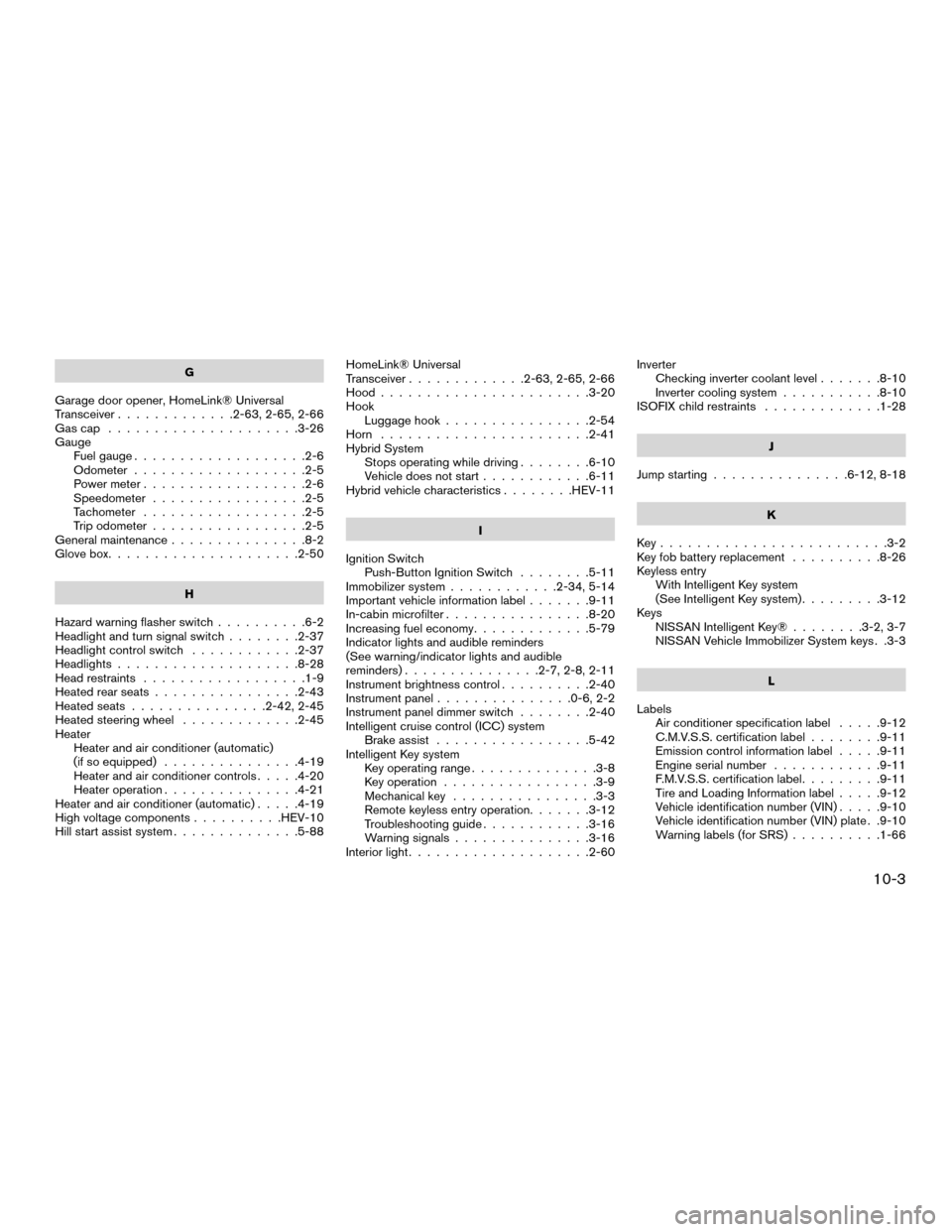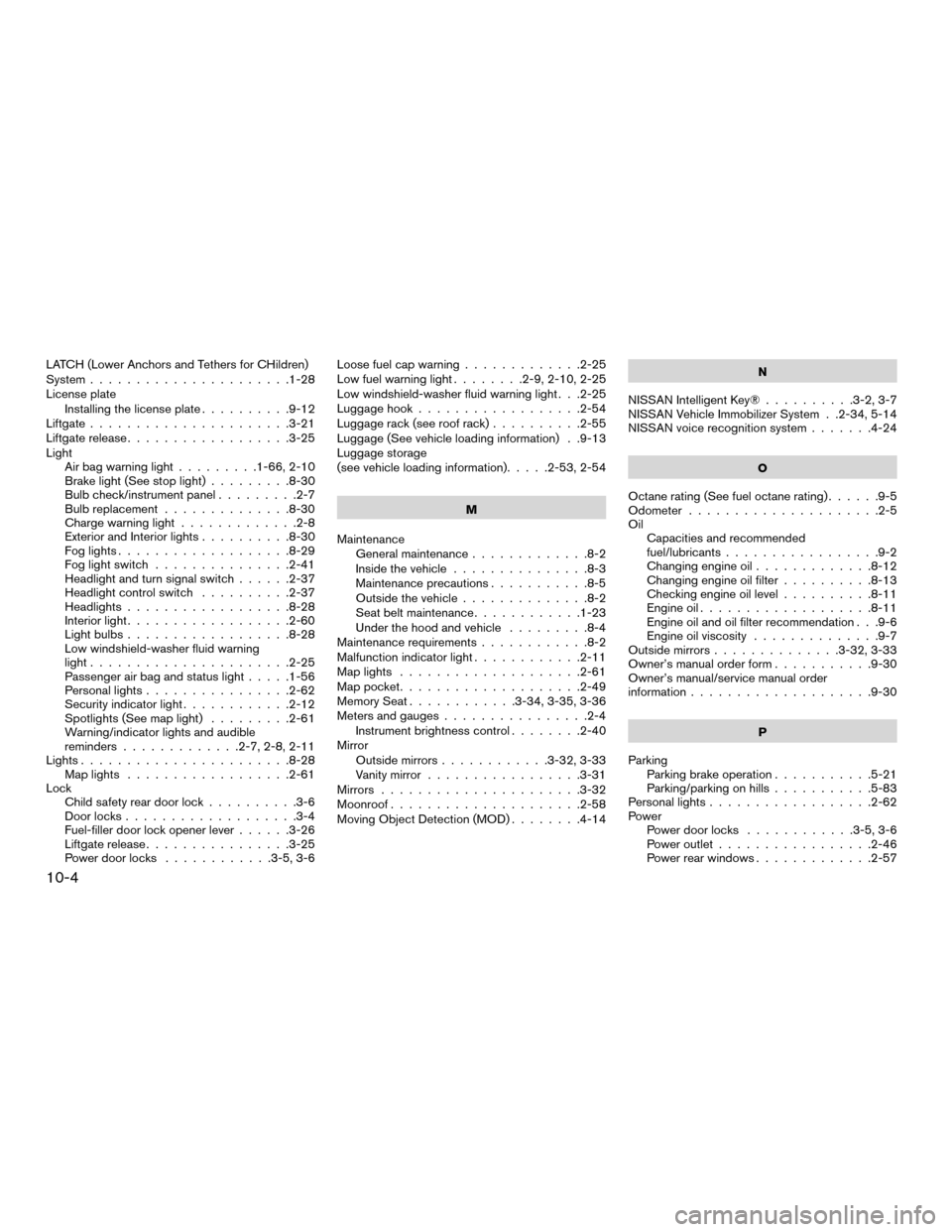2016 NISSAN MURANO HYBRID check engine light
[x] Cancel search: check engine lightPage 414 of 443

3. Try to rearrange the trailer load so it is bal-anced as described in this section.
● Be careful when passing other vehicles.
Passing while towing a trailer requires con-
siderably more distance than normal pass-
ing. Remember, the length of the trailer must
also pass the other vehicle before you can
safely change lanes.
● Downshift the transmission to a lower gear
for engine braking when driving down steep
or long hills. This will help slow the vehicle
without applying the brakes.
● Avoid holding the brake pedal down too long
or too frequently. This could cause the
brakes to overheat, resulting in reduced
braking efficiency.
● Increase your following distance to allow for
greater stopping distances while towing a
trailer. Anticipate stops and brake gradually.
● NISSAN recommends that the cruise con-
trol not be used while towing a trailer.
● Some states or provinces have specific
regulations and speed limits for vehicles that
are towing trailers. Obey the local speed
limits. ●
Check your hitch, trailer wiring harness con-
nections, and trailer wheel lug nuts after
50 miles (80 km) of travel and at every break.
● When launching a boat, don’t allow the wa-
ter level to go over the exhaust tail pipe or
rear bumper.
● Make sure you disconnect the trailer lights
before backing the trailer into the water or
the trailer lights may burn out.
When towing a trailer, final drive gear oil
should be replaced and transmission
oil/fluid should be changed more fre-
quently. For additional information, refer to
the “Maintenance and do-it-yourself” sec-
tion of this manual.
FLAT TOWING FOR ALL–WHEEL
DRIVE VEHICLE (if so equipped)
Towing your vehicle with all four wheels on the
ground is sometimes called flat towing. This
method is sometimes used when towing a vehicle
behind a recreational vehicle, such as a motor
home.
CAUTION
● Failure to follow these guidelines can
result in severe transmission damage.
● Never flat tow your All-wheel drive
(AWD) vehicle.
● DO NOT tow your All-wheel drive (AWD)
vehicle with any wheels on the ground.
Doing so may cause serious and expen-
sive damage to the powertrain.
● For emergency towing procedures refer
to “Towing recommended by NISSAN”
in the “In case of emergency” section of
this manual.
FLAT TOWING FOR FRONT WHEEL
DRIVE VEHICLE (if so equipped)
Towing your vehicle with all four wheels on the
ground is sometimes called flat towing. This
method is sometimes used when towing a vehicle
behind a recreational vehicle, such as a motor
home.
Technical and consumer information9-25
Page 418 of 443

If a powertrain system component is repaired or
the battery is disconnected, the vehicle may be
reset to a “not ready” condition. Before taking the
I/M test, check the vehicle’s
inspection/maintenance test readiness condi-
tion. Place the ignition switch in the ON position
without starting the engine. If the Malfunction
Indicator Light (MIL) comes on steady for 20 sec-
onds and then blinks for 10 seconds , the I/M test
condition is “not ready”. If the MIL does not blink
after 20 seconds, the I/M test condition is
“ready”. It is recommended that you visit a
NISSAN dealer to set the “ready condition” or to
prepare the vehicle for testing.This vehicle is equipped with an Event Data Re-
corder (EDR) . The main purpose of an EDR is to
record, in certain crash or near crash-like situa-
tions, such as an air bag deployment or hitting a
road obstacle, data that will assist in understand-
ing how a vehicle’s systems performed. The EDR
is designed to record data related to vehicle
dynamics and safety systems for a short period of
time, typically 30 seconds or less. The EDR in this
vehicle is designed to record such data as:
● How various systems in your vehicle were
operating;
● Whether or not the driver and passenger
safety belts were buckled/fastened;
● How far (if at all) the driver was depressing
the accelerator and/or brake pedal; and,
● How fast the vehicle was traveling.
● Sounds are not recorded. These data can help provide a better understand-
ing of the circumstances in which crashes and
injuries occur. NOTE: EDR data are recorded by
your vehicle only if a nontrivial crash situation
occurs; no data are recorded by the EDR under
normal driving conditions and no personal data
(e.g. name, gender, age and crash location) are
recorded. However, other parties, such as law
enforcement, could combine the EDR data with
the type of personally identifying data routinely
acquired during a crash investigation.
To read data recorded by an EDR, special equip-
ment is required and access to the vehicle or the
EDR is needed. In addition to the vehicle manu-
facturer and NISSAN dealer, other parties, such
as law enforcement, that have the special equip-
ment, can read the information if they have ac-
cess to the vehicle or the EDR. EDR data will only
be accessed with the consent of the vehicle
owner or lessee or as otherwise required or per-
mitted by law.
EVENT DATA RECORDERS (EDR)
Technical and consumer information9-29
Page 420 of 443

10 Index
A
Active noise control ...............5-90
Air bag (See supplemental restraint
system) .....................1-46
Air bag system Front (See supplemental front impact
air bag system) ...............1-54
Air bag warning labels .............1-66
Air bag warning light ...........1-66, 2-10
Air bag warning light, supplemental . .1-66, 2-10
Air Cleaner ...................8-20
Air cleaner housing filter ............8-20
Air conditioner Air conditioner specification label .....9-12
Air conditioner system refrigerant and
oil recommendations .............9-7
Air conditioner system refrigerant
recommendations ..............9-7
Heater and air conditioner (automatic)
(if so equipped) ...............4-19
Heater and air conditioner controls . . . .4-20
Servicing air conditioner ..........4-22
Alarm system
(See vehicle security system) .........2-33
Anchor point locations .............1-31
Antenna .....................4-22
Antifreeze ....................5-89
Anti-lock brake warning light ..........2-8
Anti-lock Braking System (ABS) ........5-84
Armrests .....................1-6
Around View® Monitor .............4-2 Audible reminders
...............2-13
Audio system ..................4-22
Radio ....................4-22
Autolight switch .................2-38
Automatic Automatic drive positioner . .3-34, 3-35, 3-36
Automatic power window switch .....2-57
Automatic door locks ..............3-6
Automatic drive positioner . . . .3-34, 3-35, 3-36
B
Battery ..................5-89, 8-17
Charge warning light .............2-8
Battery replacement ..............8-26
Keyfob ...................8-26
NISSAN Intelligent Key® ..........8-27
Before starting the engine ...........5-14
Belt (See drive
belt)..............8-19
Blind Spot Warning (BSW) warning
system ......................5-22
Bluetooth® Hands-Free Phone System with
Navigation System ...............4-24
Booster seats ..................1-43
Brake Anti-lock Braking System (ABS) ......5-84
Brake fluid ..................8-15
Brake light (See stop light) .........8-30
Brake system ................5-83
Brake warning light ...........2-8, 2-9
Brake wear indicators ........2-13, 8-23
Parking brake operation ..........5-21 Self-adjusting brakes
............8-23
Brake fluid ....................8-15
Brakes ......................8-23
Brake system ..................5-83
Break-in schedule ...............5-77
Brightness control Instrument panel ..............2-40
Bulb check/instrument panel ..........2-7
Bulb replacement ................8-30
C
Capacities and recommended
fuel/lubricants ...................9-2
Cargo light ...................2-62
Cargo (See vehicle loading information) . . .9-13
Car phone or CB radio .............4-23
Check tire pressure ...............2-25
Child restraints .......1-23, 1-24, 1-26, 1-28
LATCH (Lower Anchors and Tethers for
CHildren) System ..............1-28
Precautions on child
restraints ........1-26, 1-33, 1-39, 1-43
Top tether strap anchor point locations . .1-31
Child restraint with top tether strap ......1-30
Child safety rear door lock ............3-6
Chimes, audible reminders ...........2-13
Cleaning exterior and interior .......7-2, 7-4
C.M.V.S.S. certification label ..........9-11
Cold weather driving ..............5-89
Console box .................. .2-50
Continuously
Variable Transmission (CVT) . .5-16
Page 421 of 443

Continuously Variable Transmission (CVT)
fluid......................8-14
Driving with Continuously Variable
Transmission (CVT) .............5-16
Controls Heater and air conditioner controls .....4-20
Coolant Capacities and recommended
fuel/lubricants .................9-2
Changing engine coolant ...........8-9
Checking engine coolant level ........8-9
Checking inverter coolant level .......8-10
Corrosion protection ...............7-6
Cruise control ..................5-40
Cup holders ...................2-51
D
Daytime running light system (Canada only) . .2-39
Defroster switch Rear window and outside mirror defroster
switch .....................2-37
Dimensions and weights .............9-9
Dimmer switch for instrument panel ......2-40
Door locks .....................3-4
Doors ........................3-4
Drive belt .....................8-19
Drive positioner, Automatic . . . .3-34, 3-35, 3-36
Driving Cold weather driving .............5-89
Driving with Continuously Variable
Transmission (CVT) .............5-16
Precautions when starting and
driving ...................5-2, 5-9
Driving the vehicle ................5-16 E
Economy - fuel ..................5-79
Emergency engine shutoff ............6-2
Emission control information label .......9-11
Emission control system warranty .......9-27
Engine Before starting the engine ..........5-14
Capacities and recommended
fuel/lubricants .................9-2
Changing engine coolant ...........8-9
Changing engine oil .............8-12
Changing engine oil filter ..........8-13
Checking engine coolant level ........8-9
Checking engine oil level ..........8-11
Engine compartment check
locations . . . .8-7
Engine cooling system ............8-8
Engine oil ...................8-11
Engine oil and oil filter recommendation . . .9-6
Engine oil pressure warning light .......2-9
Engine oil viscosity ..............9-7
Engine serial number ............9-11
Engine specifications .............9-8
Starting the engine .............5-15
Event Data recorders ..............9-29
Exhaust gas (Carbon monoxide) .........5-2
Explanation of maintenance items ........8-2
Extended storage switch ............2-48
F
Flashers (See hazard warning flasher switch) . .6-2
Flat tire .......................6-3
Floor mat positioning aid .............7-5 Fluid
Brake fluid ..................8-15
Capacities and recommended
fuel/lubricants .................9-2
Continuously Variable Transmission (CVT)
fluid ......................8-14
Engine coolant .................8-8
Engine oil ...................8-11
Inverter coolant ................8-10
Power steering fluid .............8-15
Windshield-washer fluid ...........8-16
F.M.V.S.S. certification label ...........9-11
Fog light switch .................2-41
Forward Emergency Braking (FEB) .......2-9
Front air bag system
(See supplemental restraint system) ......1-54
Front power seat adjustment ...........1-3
Front seats .....................1-2
Fuel Capacities and recommended
fuel/lubricants .................9-2
Fuel economy ................5-79
Fuel-filler door and cap ...........3-26
Fuel-filler door lock opener lever ......3-26
Fuel gauge .................. .2-6
Fuel
octane rating ...............9-5
Fuel recommendation .............9-4
Loose fuel cap warning ...........2-25
Fuel Cell Vehicle (FCV) System Tire pressure .................8-32
Fuel-filler door ..................3-26
Fuel gauge .....................2-6
Fuses .......................8-23
Fusible links ...................8-25
10-2
Page 422 of 443

G
Garage door opener, HomeLink® Universal
Transceiver .............2-63, 2-65, 2-66
Gascap .....................3-26
Gauge Fuel gauge ...................2-6
Odometer ...................2-5
Power meter ..................2-6
Speedometer .................2-5
Tachometer ..................2-5
Trip odometer .................2-5
General maintenance ...............8-2
Glove box .....................2-50
H
Hazard warning flasher switch ..........6-2
Headlight and turn signal switch ........2-37
Headlight control switch ............2-37
Headlights ....................8-28
Head restraints ..................1-9
Heated rear seats ................2-43
Heated seats ...............2-42, 2-45
Heated steering wheel .............2-45
Heater Heater and air conditioner (automatic)
(if so equipped) ...............4-19
Heater and air conditioner controls .....4-20
Heater operation ...............4-21
Heater and air conditioner (automatic) .....4-19
High voltage components ..........HEV-10
Hill start assist system ..............5-88 HomeLink® Universal
Transceiver
.............2-63, 2-65, 2-66
Hood .......................3-20
Hook Luggage hook ................2-54
Horn .......................2-41
Hybrid System Stops operating while driving ........6-10
Vehicle does not start ............6-11
Hybrid vehicle characteristics ........HEV-11
I
Ignition Switch Push-Button Ignition Switch.......
.5-11
Immobilizer system ............2-34, 5-14
Important vehicle information label .......9-11
In-cabin microfilter ................8-20
Increasing fuel economy .............5-79
Indicator lights and audible reminders
(See warning/indicator lights and audible
reminders) ...............2-7, 2-8, 2-11
Instrument brightness control ..........2-40
Instrument panel ...............0-6, 2-2
Instrument panel dimmer switch ........2-40
Intelligent cruise control (ICC) system Brake assist .................5-42
Intelligent Key system Key operating range ..............3-8
Key operation .................3-9
Mechanical key ................3-3
Remote keyless entry operation .......3-12
Troubleshooting guide ............3-16
Warning signals ...............3-16
Interior light ....................2-60 Inverter
Checking inverter coolant level .......8-10
Inverter cooling system ...........8-10
ISOFIX child restraints .............1-28
J
Jump starting ...............6-12, 8-18
K
Key.........................3-2
Key fob battery replacement ..........8-26
Keyless entry With Intelligent Key system
(See Intelligent Key system) .........3-12
Keys NISSAN Intelligent Key® ........3-2, 3-7
NISSAN Vehicle Immobilizer System keys . .3-3
L
Labels Air conditioner specification label .....9-12
C.M.V.S.S. certification label ........9-11
Emission control information label .....9-11
Engine serial number ............9-11
F.M.V.S.S. certification label .........9-11
Tire and Loading Information label .....9-12
Vehicle identification
number (VIN) .....9-10
Vehicle identification number (VIN) plate . .9-10
Warning labels (for SRS) ..........1-66
10-3
Page 423 of 443

LATCH (Lower Anchors and Tethers for CHildren)
System......................1-28
License plate Installing the license plate ..........9-12
Liftgate ......................3-21
Liftgate release ..................3-25
Light Air bag warning light .........1-66, 2-10
Brake light (See stop light) .........8-30
Bulb check/instrument panel .........2-7
Bulb replacement ..............8-30
Charge warning light .............2-8
Exterior and Interior lights ..........8-30
Fog lights ...................8-29
Fog light switch ...............2-41
Headlight and turn signal switch ......2-37
Headlight control switch ..........2-37
Headlights ..................8-28
Interior light ..................2-60
Light bulbs ..................8-28
Low windshield-washer fluid warning
light ......................2-25
Passenger air bag and status light .....1-56
Personal lights ................2-62
Security indicator light ............2-12
Spotlights (See map light) .........2-61
Warning/indicator lights and audible
reminders .............2-7, 2-8, 2-11
Lights .......................8-28
Map lights ..................2-61
Lock Child safety rear door lock ..........3-6
Door locks ...................3-4
Fuel-filler door lock opener lever ......3-26
Liftgate release ................3-25
Power door locks ............3-5, 3-6 Loose fuel cap warning
.............2-25
Low fuel warning light ........2-9, 2-10, 2-25
Low windshield-washer fluid warning light . . .2-25
Luggage hook ..................2-54
Luggage rack(see
roof rack)..........2-55
Luggage (See vehicle loading information) . .9-13
Luggage storage
(see vehicle loading information) .....2-53, 2-54
M
Maintenance General maintenance .............8-2
Inside the vehicle ...............8-3
Maintenance precautions ...........8-5
Outside the vehicle ..............8-2
Seat belt maintenance ............1-23
Under the hood and vehicle .........8-4
Maintenance requirements ............8-2
Malfunction indicator light ............2-11
Map lights ....................2-61
Map pocket ....................2-49
Memory Seat ............3-34, 3-35, 3-36
Meters and gauges ................2-4
Instrument brightness control ........2-40
Mirror Outside mirrors ............3-32, 3-33
Vanity mirror .................3-31
Mirrors ......................3-32
Moonroof .....................2-58
Moving Object Detection (MOD) ........4-14 N
NISSAN Intelligent Key® ..........3-2, 3-7
NISSAN Vehicle Immobilizer System . .2-34, 5-14
NISSAN voice recognition system .......4-24
O
Octane rating (See fuel octane rating) ......9-5
Odometer .....................2-5
Oil Capacities and recommended
fuel/lubricants .................9-2
Changing engine oil .............8-12
Changing engine oil filter ..........8-13
Checking engine oil level ..........8-11
Engine oil ...................8-11
Engine oil and oil filter recommendation . . .9-6
Engine oil viscosity ..............9-7
Outside mirrors ..............3-32, 3-33
Owner’s manualorder
form ...........9-30
Owner’s manual/service manual order
information ....................9-30
P
Parking Parking brake operation ...........5-21
Parking/parking on hills ...........5-83
Personal lights ..................2-62
Power Power door locks ............3-5, 3-6
Power outlet .................2-46
Power rear windows .............2-57
10-4